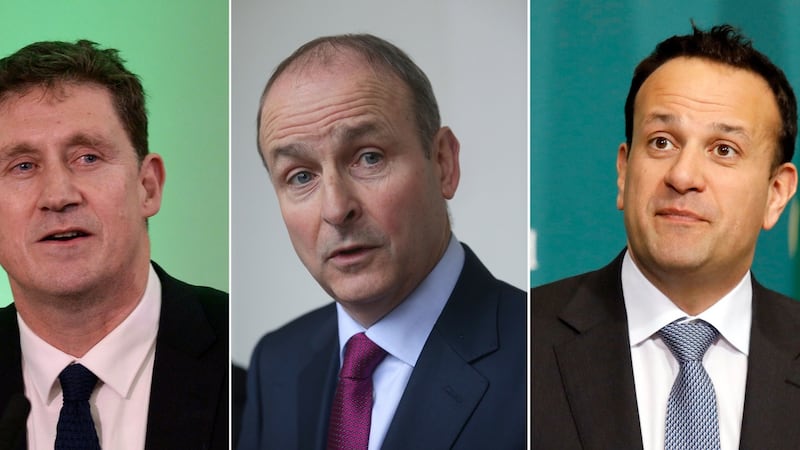One of the reasons that Fine Gael and Fianna Fáil have run every government since the 1920s is that they have been supremely responsive to the evolving whims of their voters, and endlessly pliable in changing times.
That ability to adapt, to change and – where necessary – to perform outrageous U-turns is to some people evidence of a brazen cynicism that would sell its most dearly-held principles for power; for others it embodies the centrist, consensual politics that has underpinned a moderate polity, a prosperous economy and a redistributive state.
You can take your pick.
Now, almost 100 years after the foundation of the State, the two old rivals perform their greatest ever feat of political acrobatics – agreeing to share power, not just with each other, but with the Green Party, regarded by many of their rural footsoldiers as a threat to their way of life. If they can pull it off, it will be some manoeuvre, all the same.
Two things we should acknowledge at this point. To share power with each other in a coalition government (never mind with the Greens) is a monumentally significant move for Fine Gael and Fianna Fáil, which will change their relationship forever. But for everyone else, it will feel like: what took you so long?
My hunch is that if this government is a success – in sticking together, in achieving most of its objectives, in leading the country out of the coronavirus crisis – then it will establish a natural alliance between the two parties in the future. They will never be one party; but they might as well be.
Realignment
It won’t end the rivalry, of course. That is too deep-seated to evaporate in a few years; it will last for a few generations more. But the alliance will realign Irish politics. The Fianna Fáil and Fine Gael cleavage has been less and less important in elections since 2011; in future, the left-right rivalry is likely to be more important than the Civil War one.
The radical left and Sinn Féin are already decrying the deal, and their online allies will savage the people who have put it together. There will be especial spleen reserved for the Greens, who will be accused of betraying the “change” for which people voted in February. But they expect that; it goes with politics nowadays. And Sinn Féin will relish a future in which the party gets to lead the opposition, and prepare – realistically – to lead a Dublin government.
The Greens took a clear-eyed view of their political strength and drove a hard bargain, securing key concessions, including the do-or-die 7 per cent annual reduction in greenhouse gas emissions.

The main points of the programme for government are examined elsewhere today, but it's clear that the lengthy document is strongly Green influenced. The carbon tax will go up (likely to be targeted by opponents as "Green austerity"), the planned liquid natural gas terminal on the Shannon estuary will be abandoned and there will be massive injection – a million euro a day – in walking and cycling infrastructure. They'll have problems spending it all.
The 7 per cent will be difficult and few Fine Gaelers and Fianna Fáilers believe it will achieved in full, every year. But they also know it will be underpinned by law, and can’t be ignored, long-fingered, pushed off the agenda. They know the Greens will be on their case about it every day. It will be by some distance the most radical environmental measure an Irish government has ever adopted.
There are kicks to touch aplenty, of course. Observers delighted in counting them up: seven commissions, six taskforces, four committees, 73 (!) reviews, two working groups, two forums, two councils, three citizens’ assemblies, two agencies, a court and an expert group, according to one count. But that is the nature of these things. Problems that can be solved, or have to be solved, are; others are postponed.
External environment
The big unknown, of course – which will impact on the entire performance of the government – will be the duration of the pandemic, its ultimate costs and the external economic environment that will decide if the next government can continue to borrow while meeting those costs. A deterioration in bond market sentiment could destroy the government; but you could say the same of most European governments.
There is, of course, no guarantee that the thing will get off the ground at all. While the Fianna Fáil and Fine Gael organisations are expected to ratify the agreement – though not without a fight in the former, and some reluctance in the latter – a rejection is hardly impossible, if unlikely. But the real battle will be in the Greens, where the anti-establishment tribe is numerous, and the two-thirds majority a high bar to clear. It will be a fight for the soul of the party.
The deal has already discommoded some people; others are infuriated. The public, today’s Irish Times/Ipsos MRBI poll suggests, are not exactly dancing in the streets to welcome it. But on balance, they seem content that it go ahead. Like many in the parties involved – they’re not in love with it. But they don’t have a better idea.
Whatever your view, you can hardly argue it’s not a change. It’s a big moment. Irish politics may be about to change forever.
Pat Leahy is Political Editor







